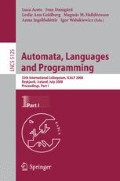Abstract
Consider a point set \({\mathcal{D}}\) with a measure function \(\mu : {\mathcal{D}} \to \mathcal{R}\). Let \({\mathcal{A}}\) be the set of subsets of \(\mathcal{D}\) induced by containment in a shape from some geometric family (e.g. axis-aligned rectangles, half planes, balls, k-oriented polygons). We say a range space \((\mathcal{D}, \mathcal{A})\) has an ε-approximation P if
We describe algorithms for deterministically constructing discrete ε-approximations for continuous point sets such as distributions or terrains. Furthermore, for certain families of subsets \(\mathcal{A}\), such as those described by axis-aligned rectangles, we reduce the size of the ε-approximations by almost a square root from \(O(\frac{1}{\varepsilon^2} \log \frac{1}{\varepsilon})\) to  . This is often the first step in transforming a continuous problem into a discrete one for which combinatorial techniques can be applied. We describe applications of this result in geospatial analysis, biosurveillance, and sensor networks.
. This is often the first step in transforming a continuous problem into a discrete one for which combinatorial techniques can be applied. We describe applications of this result in geospatial analysis, biosurveillance, and sensor networks.
Work on this paper is supported by a James B. Duke Fellowship, by NSF under a Graduate Research Fellowship and grants CNS-05-40347, CFF-06-35000, and DEB-04-25465, by ARO grants W911NF-04-1-0278 and W911NF-07-1-0376, by an NIH grant 1P50-GM-08183-01, by a DOE grant OEGP200A070505, and by a grant from the U.S. Israel Binational Science Foundation.
Access this chapter
Tax calculation will be finalised at checkout
Purchases are for personal use only
Preview
Unable to display preview. Download preview PDF.
References
Agarwal, D., McGregor, A., Phillips, J.M., Venkatasubramanian, S., Zhu, Z.: Spatial scan statistics: Approximations and performance study. In: Proceedings 12th ACM SIGKDD Knowledge Discovery & Data Mining, pp. 24–33 (2006)
Alexander, R.: Principles of a new method in the study of irregularities of distribution. Inventiones Mathematicae 103, 279–296 (1991)
Beck, J.: Balanced two-coloring of finite sets in the square I. Combinatorica 1, 327–335 (1981)
Beck, J.: Roth’s estimate on the discrepancy of integer sequences is nearly sharp. Combinatorica 1, 319–325 (1981)
Beck, J.: Irregularities of distribution I. Acta Mathematics 159, 1–49 (1987)
Beck, J.: Probabilistic diophantine approximation, I Kronecker sequences. Annals of Mathematics 140, 451–502 (1994)
Beck, J., Chen, W.: Irregularities of Distribution. Cambridge University Press, Cambridge (1987)
Beck, J., Fiala, T.: ”integer-making” theorems. Disc. App. Math. 3, 1–8 (1981)
Chazelle, B.: The Discrepancy Method. Cambridge University Press, Cambridge (2000)
Chazelle, B., Matousek, J.: On linear-time deterministic algorithms for optimization problems in fixed dimensions. Journal of Algorithms 21, 579–597 (1996)
Gandhi, S., Suri, S., Welzl, E.: Catching elephants with mice: Sparse sampling for monitoring sensor networks. In: Proceedings 5th Embedded Networked Sensor Systems, pp. 261–274 (2007)
Halton, J.H.: On the efficiency of certain quasi-random sequences of points in evaluating multidimensional integrals. Numerical Mathematics 2, 84–90 (1960)
Hammersly, J.M.: Monte Carlo methods for solving multivariable problems. Annals of New York Acadamy of Science 86, 844–874 (1960)
Kulldorff, M.: A spatial scan statistic. Comm. in Stat.: T&M 26, 1481–1496 (1997)
Matoušek, J.: Approximations and optimal geometric divide-and-conquer. In: Proceedings 23rd Symposium on Theory of Computing, pp. 505–511 (1991)
Matoušek, J.: Tight upper bounds for the discrepancy of halfspaces. Discrete and Computational Geometry 13, 593–601 (1995)
Matoušek, J.: Geometric Discrepancy. Springer, Heidelberg (1999)
Matoušek, J.: On the discrepancy for boxes and polytopes. Monatsh. Math. 127, 325–336 (1999)
Matoušek, J., Welzl, E., Wernisch, L.: Discrepancy and approximations for bounded VC-dimension. Combinatorica 13, 455–466 (1993)
Niederreiter, H.: Random Number Generation and Quasi-Monte Carlo Methods. SIAM, Philadelphia (1992)
Shrivastava, N., Suri, S., Tóth, C.D.: Detecting cuts in sensor networks. ACM Transactions on Sensor Networks 4(10) (2008)
Skriganov, M.: Lattices in algebraic number fields and uniform distributions modulo 1. Leningrad Mathematics Journal 1, 535–558 (1990)
Skriganov, M.: Constructions of uniform distributions in terms of geometry of numbers. St. Petersburg Mathematics Journal 6, 635–664 (1995)
Skriganov, M.: Ergodic theory on SL(n), diophantine approximations and anomalies in the lattice point problem. Inventiones Mathematicae 132, 1–72 (1998)
Srinivasan, A.: Improving the discrepancy bound for sparse matrices: Better approximations for sparse lattice approximation problems. In: Proceedings of the 8th Annual ACM-SIAM Symposium on Discrete Algorithms, pp. 692–701 (1997)
Suri, S., Tóth, C.D., Zhou, Y.: Range counting over multidimensional data streams. In: Proceedings 20th Symposium on Computational Geometry, pp. 160–169 (2004)
van der Corput, J.G.: Verteilungsfunktionen I. Aka. Wet. Ams. 38, 813–821 (1935)
Vapnik, V., Chervonenkis, A.: On the uniform convergence of relative frequencies of events to their probabilities. Theory of Prob. and its Applic. 16, 264–280 (1971)
Author information
Authors and Affiliations
Editor information
Editors and Affiliations
Rights and permissions
Copyright information
© 2008 Springer-Verlag Berlin Heidelberg
About this paper
Cite this paper
Phillips, J.M. (2008). Algorithms for ε-Approximations of Terrains. In: Aceto, L., Damgård, I., Goldberg, L.A., Halldórsson, M.M., Ingólfsdóttir, A., Walukiewicz, I. (eds) Automata, Languages and Programming. ICALP 2008. Lecture Notes in Computer Science, vol 5125. Springer, Berlin, Heidelberg. https://doi.org/10.1007/978-3-540-70575-8_37
Download citation
DOI: https://doi.org/10.1007/978-3-540-70575-8_37
Publisher Name: Springer, Berlin, Heidelberg
Print ISBN: 978-3-540-70574-1
Online ISBN: 978-3-540-70575-8
eBook Packages: Computer ScienceComputer Science (R0)

